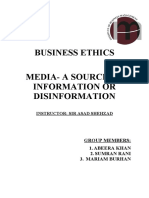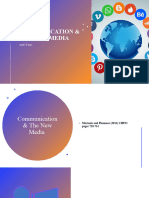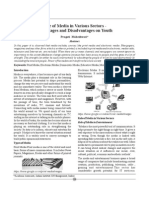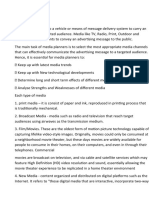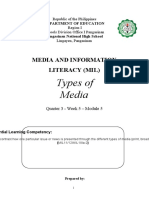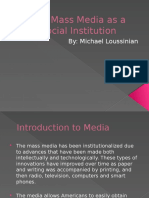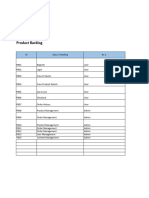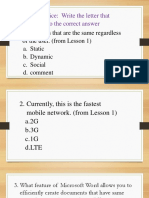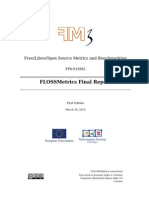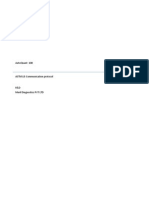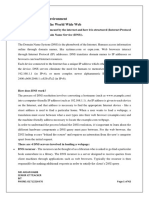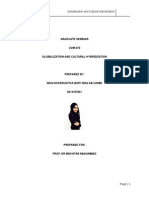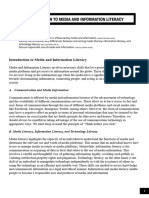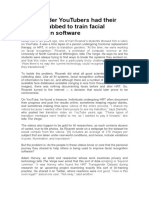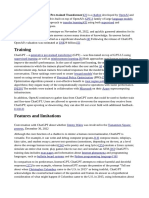•
1
� TABLE OF CONTENTS
Content Page Number
Information Sheet 1.2 The Evolution of Traditional to New Media……………..…….……………….3
Information Sheet 1.2-1 Evolution of Media from Traditional to New Media………….………......4
Self-Check 1.2-1……………………………………………………………………….……………………………..11
Activity Sheet 1.2-1…………………………………………………………………….……………………….....12
Scoring Rubrics 1.2-1……………………………………………………………………….………………………12
References……………………………………………………………………………………………………………...13
Acknowledgement…………….…………………………………………………………………..………………...14
2
� Information Sheet 1.2
THE EVOLUTION OF TRADITIONAL TO NEW MEDIA
Content Standard:
The learner demonstrates understanding of media and information literacy (MIL) and MIL
related concepts.
Performance Standard:
The learner organizes a creative and interactive symposium for the community focusing on
being a media and information literate individual.
Learning Outcome:
After reading this INFORMATION SHEET, YOU MUST be able to:
1. explain how the evolution of media from traditional to new media shaped the
values and norms of people and society
3
� Information Sheet 1.2-1
EVOLUTION OF MEDIA: FROM TRADITIONAL TO NEW MEDIA
Learning Objectives:
After reading this INFORMATION SHEET, YOU MUST be able to:
1. explain how the evolution of media from traditional to new media shaped the values
and norms of people and society;
2. identify traditional media and new media and their relationship;
3. editorialize the roles and functions of media in democratic society; and
4. search latest on information and media.
Over the decades, the significant role of media in the lives of the people has evolved.
From a simple task of disseminating information, the use of media has become more
diversified and personal. The invention of gadgets has redefined it values to its users.
Media is no longer just a source of information. It helps to bridge the economic,
political, and societal gaps. It unites people and nations. It advocates change and
propagates development for the betterment of the people and the communities.
Thomas Jefferson, the third president of United States and author of
Declaration of Independence said that if he had to choose between
government without newspapers and newspapers without a
government, he would pick the latter. This shows how the vital the role
of media is in keeping the democracy in a society.
Source:
https://pixels.com/featured/thomas-jefferson-1776-charles-willson-peale.html
Media is the foundation of a democracy. Media is the window of the people to see and
to be aware of the important happenings in the social, political, and economic scenes that
would greatly affect their lives. It mirrors the realities of life.
Media is a watchdog of the society. In an democratic society like the Philippines,
media has become the agent of public. It exposes irregularities and ambiguities in the
system of democracy, which awakens and challenges the government to correct and solve
the issues to make the system more responsive and accountable.
Media as oftentimes the only source of information, it must ensure the following:
❖ Implementation of utmost professionalism
❖ Must be objective at all times
❖ Provide the public with balanced reporting
❖ Fair and honest covering of stories or events
❖ Examine and comprehend the interest of the public
❖ Make avenue to represent different voices and opinions
The Importance of Media
John Vivian explained the importance of media in his book entitle, The Media of Mass
Communication. According to him, the value of media lies in its pervasive nature, its
function as an information source, its role as a persuasions forum, and its binding
influence on people.
4
� Pervasiveness
The Cambridge dictionary defines pervasiveness as
present or noticeable in every part of a thing or a place. This
is true in the case of media in our daily lives. Over the past
couple of decades, the world has grown more and more
dependent on media. It is for this reason that TV networks
and radio stations continue to multiply. Print media do not
seem to die down completely despite many expert
predictions. The Internet has ever been listed as a basic
human right by the United States.
Source: https://dailyutahchronicle.com/2018/03/14/richards-sinclair-broadcast-group-targets-local-media/
Information Source
The Internet has become everyone’s go-to place
whenever they need to know something. Everyone gets their
dose of news and current affairs on a particular media
platform of their choice. People even take to social media
websites for updates whenever there’s catastrophe. There is
no denying that media has become the largest source of
information.
Source: https://commons.wikimedia.org/wiki/File:Egypt_State_TV,_reliable_source_of_information.png
Entertainment Source
TV shows, music, films, books, clips and videos, and
social media, are just some of the things that the media
offers as entertainment. The wide selection of choices
made available by media ensures that there is content
suitable to anyone’s liking. This is what got people hooked
on media. After all, everyone needs to relax and be
entertained everyone in a while.
Source: https://businessjournalism.org/2016/10/4-new-movie-theater-trends/
Persuasion Forum
The media has the power to persuade people.
Swaying people’s beliefs does not happen instantly
though. Every time someone shares an opinion about a
subject, another opposing view is bound to come up. In
addition to having an influence on people’s beliefs, it also
acts as a platform for discussion and debate.
Source: https://www.voltairenet.org/article206821.html
Binding Influence
People rely on media in their daily lives. Whether it
for research on a school paper, or a recipe for a delicious
meal has become part of everyone’s mundane lives. Such
as dependence has resulted to the media’s binding
influence with its audience.
Source: https://commons.wikimedia.org/wiki/File:Child_using_a_computer.svg
5
� The Concepts of Mass Media and Media Demassification
Mass Media
Mass media refer to channels of communication that involve transmitting information
in some way, shape or form to large numbers of people. Dutton et al (1998) suggest that
traditionally the mass media has been differentiated from other types of communication in
terms of four essentials characteristics:
▪ Distance: Unlike face-to-face communication, there is considerable amount of distance
between the sender and receiver of the information in mass media. This makes mass media
impersonal, lacking immediacy, and one way.
▪ Technology: TV and radio networks won’t be able to transmit information without
satellites. Connecting to the Internet requires electronic equipment like laptops and
smartphones. Mass media communication is only possible through technology.
▪ Scale: Mass media communication deals with broadcasting information to the masses
simultaneously
▪ Commodity: Due to its massive scale and the technological equipment it requires mass
media is an expensive type of communication.
Media Demassification
Demassification is derived from the word
demassify which means to divide or break up (a
social or political unit) into its component parts.
Source: https://www.entrepreneur.com/en-au/topic/online-marketing
Unlike mass media communication where the target is everyone, demassification
divides the masses into segments before choosing which segments to target. In specifically
determining the target market and achieve the intended response.
The Evolution of Media
In the study of media, it is important to look back at how media evolved through
times. This will provide media users better understanding on the milestone set in the
history of media.
What is Traditional Media?
Traditional media, or as some refer to as old media, has been used in the
marketing/advertising world for years. When related to advertising, traditional media
encompasses that of television, newspaper, radio and magazine ads. These forms of
communication are the steadfast ways that businesses have reached both consumers and
other companies for decades. They are the roots of advertising and the most common form
utilized by businesses on a daily basis. Though traditional media is effective, over the
course of the last few years we have seen more and more businesses utilizing new media to
reach its target audiences.
What is New Media?
New media is the future of advertising. More and more consumers and businesses
rely on new media to find their information. Ultimately, new media refers to content that is
easily accessible via many different forms of digital media. When related to advertising,
some examples of new media include online advertising (retargeting, banner ads, etc.),
online streaming (radio and television) and social media advertising. Each of these are
means in which businesses have the capability to reach consumers and other businesses
with ease.
6
�PRE-INDUSTRIAL AGE (BEFORE 1700)
❖ People discovered fire, developed paper from plants, and forged weapons and tools
with stone, bronze, copper and iron.
Example Forms of Media:
Sources:
https://twitter.com/historydefined/status/1527132337279930368
https://www.metmuseum.org/art/collection/search/475001
https://www.britannica.com/topic/cuneiform
https://andy15blog.wordpress.com/2017/07/25/pre-industrial-age/
https://www.alamy.com/stock-photo/maya-codex.html?sortBy=relevant
Other Example Form of Media:
❖ Dibao in China (2nd Century)
INDUSTRIAL AGE (1700S TO 1930S)
❖ People used the power of steam, developed machine tools, established iron
production, and the manufacturing of various products (including books through the
printing press)
Example Forms of Media:
Printing press for mass production (1900) Telephone (1876)
7
� Telegraph Typewriter (1800)
Motion picture photography/ projection (1890)
Sources:
https://www.slideshare.net/markjhonoxillo/the-evolution-of-traditional-to-new-media
https://americanhistory.si.edu/collections/search/object/nmah_689864
https://www.smithsonianmag.com/arts-culture/how-the-telegraph-went-from-semaphore-to-
communication-game-changer-1403433/
Other Example Forms of Media:
❖ Newspaper – The London Gazette (1740)
❖ Commercial motion pictures (1913)
❖ Punch cards
ELECTRONIC AGE (1930S TO 1980S)
❖ The invention of the transistor ushered in the electronic age. People harnessed the
power of transistors that led to the transistor radio, electronic circuits, and the early
computers. In this age, long distance communication became more efficient.
Other Example Forms of Media:
8
�Source: https://www.slideshare.net/markjhonoxillo/the-evolution-of-traditional-to-new-media
Other Example Forms of Media:
❖ OHP
❖ LCD projectors
NEW / INFORMATION AGE (1900S TO 2000S)
❖ The Internet paved the way for faster communication and the creation of the social
network. People advanced the use of microelectronics with the invention of personal
computers, mobile devices, and wearable technology. Moreover, voice, image, sound
and data are digitalized. We are now living in the information age.
Other Example Forms of Media:
WEB BROWSERS
Mosaic (1993) Internet Explorer (1995)
Source: https://www.slideshare.net/markjhonoxillo/the-evolution-of-traditional-to-new-media
Other Example of BLOGS:
❖ Blogspot (1999)
❖ Wordpress (2003)
9
� SOCIAL NETWORKS
Source: https://www.slideshare.net/markjhonoxillo/the-evolution-of-traditional-to-new-media
Other Example of Social Network:
❖ Instagram
MICROBLOG
Other Example of Microblogs:
❖ Tumblr (2007)
Source: https://www.slideshare.net/markjhonoxillo/the-evolution-of-traditional-to-new-media
VIDEO
Example of Video:
❖ YouTube (2005)
AUGMENTED REALITY / VIRTUAL REALITY
VIDEO CHAT SEARCH ENGINES
Source: https://www.slideshare.net/markjhonoxillo/the-evolution-of-traditional-to-new-media
Other Example of Search engines:
❖ Yahoo (1995)
10
�OTHER FROMS OF NEW AGE:
Source: https://www.slideshare.net/markjhonoxillo/the-evolution-of-traditional-to-new-media
Self- Check 1.2-1
Multiple Choice: Select the letter that corresponds to the correct answer. Use a separate
sheet of paper for your answers.
1. Why is media referred to as the fourth branch of the government?
a. Because they can convey information to a broad audience.
b. All of these are correct.
c. Because of the power they wield and the oversight function they exercise.
d. Because they can uncover abuses.
2. According to a contemporary thinker, Amartya Sen, what are the important requirements
of a good public policy?
a. None of these is correct. c. Public debates & mobilization
b. Information & critical public discussion d. Mobilization & public discussion
3. How do media contribute to ease social conflicts?
a. By making the marginalized irrelevant
b. By being the voice of the marginalized
c. By neglecting the marginalized
d. By hiding the opinions of the marginalized
4. During this age, the written form of communication was developed.
a. Industrial Age b. Electronic Age c. Stone Age d. Information Age
5. What is new media?
a. Printed information c. Word of mouth
b. Offline information d. Content made available in the internet
11
� Activity Sheet 1.2-1
Interview three member of your family on how new media have changed their lifestyle.
Based on your interview write a reflection paper. Use a separate sheet of paper for your
answer.
The number of words must be 450-500.
The reflection paper will be graded according to the rubric below.
Scoring Rubrics 1.2-1
Criteria Excellent (8 – 10 Good (6-7 points) Fair (3-5 points) Poor (0–2points)
points)
Focus & Details There is one clear, There is one clear, There is one topic. The topic and main
well- focused well- focused topic. Main ideas are ideas are not clear
topic. Main ideas Main ideas are clear somewhat clear.
are clear and are but are not well
well supported by supported by detailed
detailed and information.
accurate
information.
Organization The introduction The introduction The introduction There is no clear
is inviting, states states the main topic states the main topic. introduction,
the main topic, and provides an A conclusion is structure, or
and provides an overview of the paper. included. conclusion.
overview of the A conclusion is
paper. Information included.
is relevant and
presented in a
logical order. The
conclusion is
strong.
Voice The author’s The author’s purpose The author’s purpose The author’s purpose
purpose of writing of writing is of writing is of writing is unclear.
is very clear, and somewhat clear, and somewhat clear, and
there is strong there is some there is evidence of
evidence of evidence of attention attention to audience.
attention to to audience. The The author’s
audience. The author’s knowledge knowledge and/or
author’s extensive and/or experience experience with the
knowledge and/or with the topic is/are topic is/are limited.
experience with evident.
the topic is/are
evident.
Word Choice The author uses The author uses vivid The author uses The writer uses a
vivid words and words and phrases. words that limited vocabulary.
phrases. The The choice and communicate clearly, Jargon or clichés
choice and placement of words is but the writing lacks may be present and
placement of inaccurate at times variety. detract from the
words seems and/or seems meaning.
accurate, natural, overdone.
and not forced.
Sentence All sentences are Most sentences are Most sentences are Sentences sound
Structure, well constructed well constructed and well constructed, but awkward, are
Grammar, and have varied have varied structure they have a similar distractingly
Mechanics, & structure and and length. The structure and/or repetitive, or are
Spelling length. The author author makes a few length. The author difficult to
makes no errors errors in grammar, makes several errors understand. The
in grammar, mechanics in grammar, author makes
mechanics, understanding, mechanics, and/or numerous errors in
and/or spelling. and/or spelling, but spelling that interfere grammar,
they do not interfere with understanding. mechanics, and/or
with spelling that interfere
understanding. with understanding
12
�References:
Edward D. Gonzales, MEDIA AND INFORMATION LITERACY, (Pasay City: JFS Publishing
Services, 2016),4-94.
“Models of Communication”, lumen, CST 100 Principles of Public Speaking, 2020,
https://courses.lumenlearning.com/vccs-cst100-17fa/chapter/models-of-
communication/ (June 30, 2020)
Celenegoh, “Is Shannon and Weaver’s (1954) model of communication complete?”,
Wordpress, July 19, 2017, https://celenegoh.wordpress.com/2017/07/19/is-
shannon-and-weavers-1954-model-of-communication-complete/ (July 1,2020)
Rathinaswamy, Jayaseelan, “David Berlo’s Model of Communication”, Blogspot, July 20,
2017 http://jayaseelansr.blogspot.com/2017/07/david-berlos-model-of-
communication.html (July 1, 2020)
Abrahams, Andrew, “10 Levels of Intimacy in Today’s Communication”, Overdrive
Interactive, August 20, 2009, https://www.ovrdrv.com/blog/10-levels-of-intimacy-
in-todays-communication/ (July 6, 2020)
https://www.saydaily.com/.image/c_limit%2Ccs_srgb%2Cq_auto:good%2Cw_410/MTM0O
Dg3OTkwOTMyNTc1NTA2/screen-shot-2015-12-03-at-22820-pmpng.webp (July 7,
2020)
https://pngtree.com/freepng/facebook-logo-social-media-icon_3572492.html (July 8,
2020)
https://palereddot.org/wp-content/uploads/2016/01/featured_paul_gilster-672x372.jpg
(July 8,2020)
“Essay Rubric”, readwritethink, International Reading Association/NCTE, 2013,
http://www.readwritethink.org/files/resources/printouts/Essay%20Rubric.pdf
(July 8, 2020)
“Reflection Paper”, studylib.net, 2013-2020,
https://studylib.net/doc/7132606/reflection-paper (July 8, 2020)
“Different Types of Media”,
http://osou.ac.in/eresources/Different%20types%20of%20media%20and%20reporti
ng.pdf (July 27,2020)
“Information Literacy Guide: Types of Information Sources”, University of Fort Hare,
December 8, 2015, https://ufh.za.libguides.com/c.php?g=91523&p=590868 (july
28,2020)
“Literature During the Spanish Period”, Linkedln Corporation, 2020,
https://www.slideshare.net/markvincentmillona1/literature-during-the-spanish-
period (July 29, 2020)
13
� Acknowledgement
This Self-Learning Module was developed for Senior High School students of the K to 12
Curriculum with the assistance of the following persons:
This Self-Learning Module # 1.2 in Media and Information Literacy For Senior High
School was developed by the following personnel:
MODULE WRITER COVER PAGE DESIGNER
ARES JUDE MOYA MALINIS, ME MARYROSE LIGO REYES
SHS T-II SHS T-II
Polangui General Comprehensive Balogo National High School
High School Oas South District
Polangui North District
QUALITY ASSURERS
TECHNICAL SPECIFICATIONS AND STANDARDS LANGUAGE EDITOR
EDISON L. MALLAPRE RICO B. CARINAN
EPS- I, LRMS T-II, PGCHS
SDO-ALBAY
14




